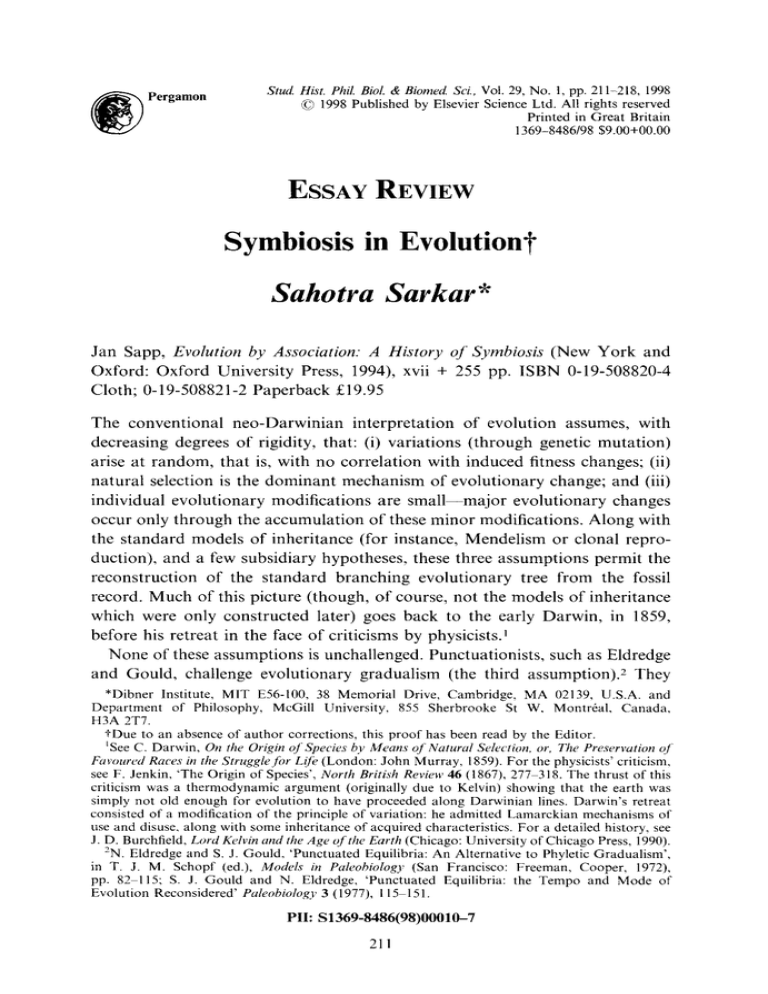
Pergamon
Stud. Hist. Phil. Biol. & Biomed Sci., Vol. 29, No. 1, pp. 211-218, 1998
© 1998 Published by Elsevier Science Ltd. All rights reserved
Printed in Great Britain
1369-8486/98 $9.00+00.00
ESSAY REVIEW
Symbiosis in Evolutiont
Sahotra Sarkar*
J a n Sapp, Evolution by Association: A H i s t o r y o f S y m b i o s i s ( N e w Y o r k a n d
O x f o r d : O x f o r d U n i v e r s i t y Press, 1994), xvii + 255 pp. I S B N 0-19-508820-4
Cloth; 0-19-508821-2 P a p e r b a c k £19.95
T h e c o n v e n t i o n a l n e o - D a r w i n i a n i n t e r p r e t a t i o n o f e v o l u t i o n assumes, with
d e c r e a s i n g degrees o f rigidity, that: (i) v a r i a t i o n s ( t h r o u g h genetic m u t a t i o n )
arise at r a n d o m , t h a t is, with no c o r r e l a t i o n with i n d u c e d fitness changes; (ii)
n a t u r a l selection is the d o m i n a n t m e c h a n i s m o f e v o l u t i o n a r y change; a n d (iii)
i n d i v i d u a l e v o l u t i o n a r y m o d i f i c a t i o n s are s m a l l - - m a j o r e v o l u t i o n a r y c h a n g e s
occur o n l y t h r o u g h the a c c u m u l a t i o n o f these m i n o r modifications. A l o n g with
the s t a n d a r d m o d e l s o f i n h e r i t a n c e (for instance, M e n d e l i s m o r clonal r e p r o duction), a n d a few s u b s i d i a r y h y p o t h e s e s , these three a s s u m p t i o n s p e r m i t the
r e c o n s t r u c t i o n o f the s t a n d a r d b r a n c h i n g e v o l u t i o n a r y tree f r o m the fossil
record. M u c h o f this picture (though, o f course, n o t the m o d e l s o f i n h e r i t a n c e
which were o n l y c o n s t r u c t e d later) goes b a c k to the early D a r w i n , in 1859,
before his r e t r e a t in the face o f criticisms by physicists.
N o n e o f these a s s u m p t i o n s is unchallenged. Punctuationists, such as Eldredge
and G o u l d , challenge e v o l u t i o n a r y g r a d u a l i s m (the third a s s u m p t i o n ) # They
*Dibner Institute, MIT E56-100, 38 Memorial Drive, Cambridge, MA 02139, U.S.A. and
Department of Philosophy, McGill University, 855 Sherbrooke St W, Montr6al, Canada,
H3A 2T7.
+Due to an absence of author corrections, this proof has been read by the Editor.
ISee C. Darwin, On the Origin of Species by Means of Natural Selection, or, The Preservation o#
Favoured Races in the Struggle for LiJe (London: John Murray, 1859). For the physicists' criticism,
see F. Jenkin, 'The Origin of Species', North British Review 46 (1867), 277 318. The thrust of this
criticism was a thermodynamic argument (originally due to Kelvin) showing that the earth was
simply not old enough for evolution to have proceeded along Darwinian lines. Darwin's retreat
consisted of a modification of the principle of variation: he admitted Lamarckian mechanisms of
use and disuse, along with some inheritance of acquired characteristics. For a detailed history, see
J. D. Burchfield, Lord Kelvin and the Age of the Earth (Chicago: University of Chicago Press, 1990).
2N. Eldredge and S. J. Gould, 'Punctuated Equilibria: An Alternative to Phyletic Gradualism',
in T. J. M. Schopf (ed.), Models in Pah, obiology (San Francisco: Freeman, Cooper, 1972),
pp. 82 115; S. J. Gould and N. Eldredge, 'Punctuated Equilibria: the Tempo and Mode of
Evolution Reconsidered' Paleobiology 3 (1977), 115 151.
PII: S1369-8486(98)00010-7
211
212
Studies in History and Philosophy o f Biological and Biomedical Sciences
claim that the paleontological record shows that evolution has consisted of long
periods of stasis punctuated by short bursts of rapid change. However, it is far
from clear that their challenge cannot be straightforwardly met within conventional neo-Darwinism: a mathematical analysis of the process of selection
unearths many models which, at the macro-evolutionary level, would give rise
to punctuated patterns in the paleontological record. 3 Neutralists, following
Kimura 4 and King and Jukes, 5 urge that, at least at the molecular level (that is,
the level of D N A and protein), most mutations are neutral with respect to
fitness. Stochastic survival or extinction, rather than functional success or
failure, determines what remains and what gets pruned from the evolutionary
tree. At the bacterial level and, perhaps, at the level of the simplest
eukaryotes--there is ample evidence that some variation (that is, mutation) is
not random but 'directional', that is, more prone to occur when they induce an
increase in fitness. 6
What is perhaps even more interesting--and reveals the extent to which the
basic precepts of evolutionary theory are underdetermined by experimental
evidence is that at least the first two of these heresies have had significant
adherents at every stage of the history of evolutionary theory. The punctuationists were preceded, for instance, by Goldschmidt who championed the
existence of macromutations in the 1940s, 7 by de Vries and his 'mutation
theory' during the early years of Mendelism 8 and, more than a century ago, by
T. H. Huxley and the saltationists. 9 The neutralists were preceded by no less a
figure than Wright, one of the founders of the modern theory of evolution. As
early as 1931, Wright argued that population structure (for instance, breeding
patterns) and stochastic factors in small populations may be more important
than fitness differences in generating evolutionary change. 1° Even earlier, in
1921, Hagedoorn and Hagedoorn-Vorsheuvel la Brand argued for a pluralistic
account of evolution in which natural selection was not given the dominant
status that it has in the conventional interpretation of evolution. 11 Instead,
stochastic (random) factors were emphasized, especially in the explanation of
extinction.
3j. Maynard Smith, 'The Genetics of Stasis and Punctuation', Annual Review of Genetics 17
(1983), 11-25.
4M. Kimura, 'Evolutionary Rate at the Molecular Level', Nature 217 (1968), 624--626.
5j. L. King and T. H. Jukes, 'Non-Darwinian Evolution,' Science 164 (1969), 788-798.
6For reviews, see S. Sarkar, 'Lamarck contre Darwin, Reduction versus Statistics: Conceptual
Issues in the Controversy over Directed Mutations in Bacteria', Boston Studies in the Philosophy of
Science 129 (1991), 235 271, and P. Foster, 'Adaptive Mutation: the Uses of Adversity', Annual
Review of Microbiology 47 (1993), 469 504.
YR. Goldschmidt, The Material Basis of Evolution (New Haven: Yale University Press, 1940).
8H. de Vries, Die Mutationstheorie. Versuche und Beobachtungen iiber die Entstehung der Arten im
Pflanzenreich. Vol. 1. Die Entstehung der Arten durch Mutation (Leipzig: Veit, 1901).
9T. H. Huxley, 'Darwin on the Origin of Species', Westminster Review 17 (1860), 541 570.
l°S. Wright, 'Evolution in Mendelian Populations', Genetics 16 (1931), 97-159.
I~A. L. Hagedoorn and A. C. Hagedoorn-Vorstheuvel la Brand, The Relative Value of the
Processes Causing Evolution (The Hague: Martinus Nijhoff, 1921).
Symbiosis in Evolution
213
These disputes by no means exhaust w h a t has at least sometimes been
f o u n d to be controversial in evolutionary theory. However, in the present
context, w h a t is most interesting a b o u t them is that, for all the passion,
intellectual turmoil, and experimental w o r k that they have generated, they do
not question one very basic aspect o f evolutionary theory, especially its
reconstruction o f evolutionary history? 2 This is the assumption that evolutionary change, besides extinctions, consists entirely o f divergence f r o m
existing lineages (that is, evolutionary history can be represented by the
familiar tree d i a g r a m which goes back to Darwin). Yet, almost t h r o u g h o u t
the history o f evolutionary theory, there has been a heretical minority
tradition that maintains that during the course o f evolution there have
occasionally been convergences, fusions o f species (even f r o m different taxa)
to f o r m new species. Such a possibility seems to have been first suggested in
1868 when Schwendener suggested that lichens were associations between
algae and fungi (rather than being a distinct class o f plants by themselves). ~3
Other lichenologists were less than enthusiastic: to turn lichens into algae and
fungi was to deny a reason for the existence o f their research domain,
Nevertheless, in 1877 F r a n k coined the term ' S y m b i o t i s m u s ' to describe the
p h e n o m e n o n ; in 1878, de Bary, one o f the most prominent o f the early
workers in the field, called it ' s y m b i o s e ' ? 4 A new natural p h e n o m e n o n ,
'symbiosis' had not only been discovered but also named. Those w h o
believed it (that is, that it existed) and pursued it came f r o m a variety o f
fields; most o f them were so taken by the p h e n o m e n o n that they urged that it
was a central process o f evolutionary change.
Jan Sapp's book, which is the subject o f this notice, is a history o f symbiosis
f r o m the 1870s to the 1980s, t h o u g h he is willing to concede that the pursuit o f
symbiosis m a y only have been 'a dissenting f o o t n o t e ' to the history o f o r t h o d o x
evolutionary theory (p. xiv). This is the first extended history o f symbiosis. It is
an i m p o r t a n t and welcome addition to the history o f biology especially because
12perhaps the only controversy which can be seen as truly threatening conventional theory is that
about the non-randomness of variation (see, for example, R. E. Lenski and J. E. Mittler, 'The
Directed Mutation Controversy and Neo-Darwinism', Science 259 (1993), 188-194). The main
reason for the depth of the resistance to this possibility seems to be that an non-random variation
must, in some sense, be induced by the environment. If such a variation is inherited, then one has
the inheritance of an 'acquired' characteristic or Lamarckism as it is (inaccurately) called, which
remains one of the taboos of modern evolutionary biology. The origins of this taboo are largely
political (in a broad sense), from fraudulent reports by Lamarckians in the 1920s (see, e. g., P.
Kammerer, The Inheritance of Acquired Characteristics (New York: Boni and Liveright, 1924)) to
the persecution of orthodox geneticists by the Lamarckians in the Soviet Union during the Lysenko
era. For a very interesting attempt to extend evolutionary theory to allow non-random variation
and its inheritance, see E. Jablonka and M. Lamb, M., Epigenetic Inheritance and Evolution: The
Lamarckian Dimension (New York: Oxford University Press, 1995).
~3S. Schwendener, 'Untersuchungen fiber den Flechtenthallus', Beitriige zur wissenschaftlichen
Botanik 6 (1868), 15 37. See J. Sapp, Evolution by Association: A History of Symbiosis (New York:
Oxford University Press, 1994), pp. 4-6 for more detail.
14See Sapp, op. cit. in note 13, pp. (~7.
214
Studies in History and Philosophy of Biological and Biomedical Sciences
most histories of evolutionary biology have ignored symbiosis altogether. ~5 By
focusing on experimental studies of symbiosis (rather than the sometimes
mystical and often polemical writings of its adherents), Sapp constructs a
history that emphasizes how relatively conventional biological concerns guided
experimental work on symbiosis, that is, how this work fell squarely within the
acceptable domains of biological investigation in spite of the researchers'
theoretical heresies. It is a meticulous history, with just enough biological detail
to be self-contained, and enough interpretive distance to be of general interest.
The political c o n t e x t s ~ . g , how symbiosis as mutualism was incorporated into
Kropotkin's social theories, or how it dominates the 'Gaia' responses to current
environmental problems--are also treated, though only cursorily.
Sapp is sensitive to the nuances of the term 'symbiosis', the multiple
meanings associated with it that continue to be used even today, and the
vagueness of many discussions in which that term is invoked without any
explicit delineation of its intended scope. As Sapp puts it:
While many equate symbiosis with mutual benefit of associated species, others have
continuously argued that this narrow meaning of the term is difficult, if not impossible
to apply to real associations. Some have applied the term to relations between
individuals; others insist that it be restricted to interspecies relations; still others have
limited it further to apply only to relations between species which remain in contact
throughout most or all of their life (p. xv).
Sapp does not attempt to adjudicate these disputes suggesting, somewhat
unconvincingly, that the existence of multiple meanings of 'symbiosis' presents
no worse problem than the existence of multiple meanings of other biological
terms such as 'species', 'heredity' or 'gene'. J6 Rather, he navigates the disputed
territories with care, paying attention to the differences but, nevertheless,
presenting a unified history in the end. 17
The early chapters of the book discuss the origins of symbiosis in lichenology
and its career in various research institutes, particulary in France and Russia.
This story is interesting because modern enthusiasts of symbiosis often invoke
this 'prehistory' to remind the biological community of the allegedly undeserved neglect with which mainstream biologists had treated figures such as
Schimper and Altman in Germany, and Famintsyn and Merezhovskii in
~SSee, for example, E. Mayr, The Gro~th ~f Biological Thought: Diversity, Evolution, and
Inheritance (Cambridge, MA: Harvard University Press, 1982).
t6The reason why this is not fully convincing is that, whereas works using these other terms
routinely do not explicitly define them, almost any modern treatment of symbiosis begins with an
explicit attempt to define that term see, for example, V. Ahmadjian and S. Paracer, Symbiosis: An
Introduction to Biological Associations (Hanover, NH: University Press of New England, 1986).
17The reason that this unity can be maintained is that the alternative definitions and uses of
'symbiosis' are quite easily codified into a consistent unitary scheme see, e . g . M . P . Starr, 'A
Generalized Scheme for Classifying Organismic Associations', Symposia of the Society Jot
Experimental Biology 29 (1975), 1 20. Sapp underestimates the importance of this f a c t o ~ w i t h o u t
it, a much more discordant story would have to be told.
Symbiosis in Evolution
215
Russia. ~s Such historical claims are often little more than ill-disguised ploys to
demand ever more attention to the modern work on symbiosis. Though Sapp
does not draw this conclusion, the story that he constructs undermines these
claims. Symbiosis, though probably never at the forefront of evolutionary
thought anywhere, was not neglected either. Symbiosis projects struggled along,
especially in France, but progress was slow: the 1950 second edition of
Caullery's Le parastisme et symbiose was almost identical to the 1922 edition.19
Though Sapp's account emphasizes continuity rather than abrupt change, it
is at least arguable that attitudes towards symbiosis, especially about its relative
importance in biology, underwent a radical transformation in the molecular
era. In spite of the long history of studies of symbiosis, its real emergence as an
important biological process was a result of the reconceptualization of cellular
organization that was brought about by molecular biology. To simplify an
interesting and complex story, for which Sapp could have provided much more
detail without any loss of narrative balance, the problem that led to this
transformation was the complexity of the relationship between bacteria and
viruses. Lederberg, in particular, argued for an analogy between this relation
(particularly in the case of lysogenic bacteria) and the relation between cells and
their cytoplasmic hereditary components (the so-called 'plasmagenes'). 2° He
suggested that everything from what was conventionally called 'infection' to the
association between cells and viruses or plasmagenes could be regarded as
different degrees of symbiosis. 21 Lederberg's prominence as a geneticist and his
continued advocacy of this position gave credence to a view of cells as
consisting of integrated symbiotic units.
Nevertheless, this resurrection of symbiosis would probably have ended with
the marginalization of the plasmagene models and the emergence of nuclear
D N A as the sole arbiter of cellular fate but for startling developments in the
1960s. Beginning with the work of Ris and Plaut in 196222 and Nass and Nass
in 196323 it was shown that chloroplasts and mitochondria had D N A and that
there was undeniable homology between this D N A and that of blue-green
algae (in the case of the chloroplasts) and bacteria (in the case of the
~SSee L. Margulis, 'Symbiogenesis and Symbionticism', in L. Margulis and R. Fester (eds),
Symbiosis as a Source of Evolutionary Innovation (Cambridge, MA: MIT Press, 1991), pp. 1 14.
19See M. Caullery, Leparasitisme et symbiose (Paris, Dion, 1922) and M. Caullery, Leparasitisme
et ~ymbiose, 2nd edn (Paris, Dion). It was actually the latter, not the former that was translated in
to English in 1952: M. Caullery, Parasitism and Symbiosis (London: Sidgwick & Jackson, 1952),
contrary to what Sapp implies (op. cit. in note 13, p. 106).
20j. Lederberg, 'Genetic Studies with Bacteria', in L. C. Dunn (ed.), Genetics in the 20th CentmT:
Essays on the Progress o.1" Genetics during Its First 50 Years (New York: Macmillan, 1951),
pp. 263-289.
21j. Lederberg, 'Cell Genetics and Hereditary Symbiosis', Physiological Reviews 32 (1952),
403~430.
22H. Ris and W. Plaut, 'Ultrastructure of DNA-Containing Areas in the Chloroplast of
Chlamydomonas', Journal of Cell Biology 19 (1962), 383-391.
23S. Nass and M. M. K. Nass, 'Intramitochondrial Fibers with DNA Characteristics', Journal of
('ell Biology 19 (1963), 613-628.
216
Studies in History and Philosophy o f Biological and Biomedical Sciences
mitochondria). By 1967 Margulis had synthesized the various suggestions; she
argued forcefully that the origin of eukaryotic cells had to be regarded as a
succession of endosymbioses. 24 Later experimental work has so far been
consistent with this model. At least during that stage of evolution when the
eukaryotic cells were first being formed, evolutionary history cannot be
represented as a single branching tree. Different lineages merged to form the
eukaryotes from which more complex organisms developed: it is only during
the latter stage of evolutionary history that the conventional tree remains
appropriate.
Margulis has since attempted to extend the domain of symbiosis well
beyond this relatively circumscribed context. Since the early 1970s, along with
Lovelock, she has argued that the entire biosphere should be regarded as a
complex adaptive system, which Lovelock calls 'Gaia'. 25 The relations between
many of the parts of this system are supposed to be symbiotic. Sapp's book
ends with a brief account of this somewhat odd direction in which symbiosis
research has lately gone. Unfortunately, his discussion of the religious and
cultural determinants of this development leaves much to be desired. The
critical question is whether the 'Gaia' hypothesis can at all be seen as a
development largely motivated by 'internal' or intellectual concerns of the
various research traditions of symbiosis. By emphasizing the alleged scientific
basis of 'Gaia', Sapp seems to suggest that its origin can largely be attributed
to intellectual factors but the case for this is far from plausible.
Meanwhile, the symbiosis story continues. Perhaps the most astonishing
suggestion of recent years is that the evolution of some marine species is to be
explained by the fusion of germinal cells from different species. As evidence,
besides an interpretation of the life histories of several echinoderms, Williamson
(the author of the new model) has offered apparently fertile offspring from sea
urchin (Echinus esculentus) sperm and tunicate (Ascidia mentula) eggs. 26
Williamson's model will, of course, require much experimental testing. Though
the requisite technologies are already available, its sheer novelty (and
implausibility, from the orthodox point of view) will probably dissuade
investigators from pursuing it seriously. A definitive answer does not appear to
be immediately forthcoming. Nevertheless, it is whether such processes exist or
not that will determine the ultimate fate of the conventional evolutionary trees,
whether they can even be maintained for the period since the formation of the
first eukaryotic cells.
24L. Sagan, 'On the Origin of Mitosing Cells', Journal of Theoretical Biology 14 (1967), 225 274.
25j. Lovelock, Gaia: A New Look at Life On Earth (Oxford: Oxford University Press, 1979).
26D. I. Williamson, 'Incongruous Larvae and the Origin of Some Invertebrate Life-Histories',
Progress in Oceanography 19 (1988), 87 116; D. I. Williamson, 'Sequential Chimeras', Boston
Studies in the Philosophy of Science 129 (1991), 299 336; D. I. Williamson, Larvae and Evolution."
Toward a New Zoology (New York: Chapman & Hall, 1992).
Symbiosis in Evolution
217
There are two intriguing questions that Sapp leaves partly unanswered: (i)
how important could symbiosis have been in evolution, that is, beyond the
critical role that it played in the genesis of eukaryotic cells, does the work that
has been done so far suggest that it may have continued to be important in
evolutionary processes?; and (ii) how important was the pursuit of symbiosis in
the historical development of biology? It is, of course, unfair to demand that a
historian answer the first question. (It is probably particularly unfair these days
when methodologically sophisticated historians eschew any distinction between
the truth and falsity of scientific claims.) Nevertheless, there is an unusual
reason why a historian, especially one who has investigated the experimental
record with as much attention to detail as Sapp has, might have some important
insights to contribute on this problem.
Most historians and philosophers of biology now agree that the development
of the life sciences in the 20th-century has routinely involved a narrowing of
focus, casting aside from what is promulgated as the legitimate domain of
inquiry all phenomena that did not adhere to the current orthodoxy. In
genetics, Sapp's earlier (and very influential) work showed how phenomena
that did not fit the nucleocentric model of heredity were relegated to the
outskirts of genetics during the development of that model. 27 In evolutionary
theory, Jablonka and Lamb have recently argued that phenomena indicating
the inheritance of some acquired characteristics were similarly ignored. 28 One
cannot help wondering whether similar displacements occurred during the
history of symbiosis, that is, intriguing bits of data were summarily dismissed
or not pursued because they were at odds with the orthodoxy. If so, then it is
particularly important that radical new suggestions of symbiosis, such as that of
Williamson, be pursued with vigor. Should such suggestions turn out to be true,
symbiosis must form part of the general expansion of evolutionary theory
beyond its orthodox confines that is going on at present. 29 Otherwise, symbiosis
is still important, but its importance can be localized to the period of
evolutionary history leading to the first eukaryotic cells. It is Sapp's misfortune
that his earlier work raised so many questions, and set such high standards, that
he is faced with such demands in what is certainly a much murkier context.
However, a historian can be expected to attempt some answer to the second
question. Where did symbiosis fit into biological research, and how important
was it? Was it really only a 'dissenting footnote' to the history of evolutionary
theory, to be historically studied primarily as a curiosity? Sapp provides partial
27j. Sapp, Beyond the Gene: Cytoplasmic" Inheritance and the Struggle for Authority in Genetics
(New York: Oxford University Press, 1987).
ZSJablonka and Lamb, op. cit. in note 12, pp. 2(~27.
29See, e.g. Jablonka and Lamb, op. cit. in note 12; M.-W. Ho and P. T. Saunders (eds), Beyond
Neo-Darwinism: An Introduction to the New Evolutionary Paradigm (London, Academic Press,
1984); and S. J. Gould, 'Darwinism and the Expansion of Evolutionary Theory', Science 216
(1982), 380-387.
218
Studies in History and Philosophy o f Biological and Biomedical Sciences
answers. His account suffices to rule out any truly important influence of
symbiosis research on evolutionary biology (or in other biological subdisciplines) in the (roughly) 1900 50 period, that is, after the full realization of
the symbiotic nature of lichens but before the advent of molecular biology. It
also shows (but this is well-known) that the work on the symbiotic origins of
eukaryotic cells during the 1960s is of undeniable importance. But, what about
the 1950s, for instance, the work of Lederberg that was already mentioned
above? Should this early work at the molecular--or, at least, sub-cellular--level
be regarded as setting the stage for the remarkable developments of the 1960s?
Sapp largely avoids this question, presumably because of a reluctance (which is
again standard among contemporary historians) to posit any linear progress.
However, an answer to this question is historiographically important. If there
was such a direct influence from the 1950s, then symbiosis owes its revival as
an important evolutionary process precisely to those differences in the
conceptualization of biology that the molecular era induced. Molecular
biology, in this case, rejuvenated an older biological sub-discipline, rather than
marginalized it. Thus, symbiosis research may provide a striking counterexample to the thesis that molecularization has constricted biological research
which is currently fashionable among many historians of biology. 3° Rather, to
the extent that work on symbiosis has led to an expansion of evolutionary
theory in very interesting ways, the credit for that must go to the advent of the
molecular era. Sapp's book provides the background for pursuing this rather
intriguing prospect.
3°See, e.g.S. Gilbert, 'Enzymatic Adaptation and the Entrance of Molecular Biology in
Embryology',in S. Sarkar (ed.), The Philosophy and History of Molecular Biology: New Perspectives
(Dordrecht: Kluwer, 1995).

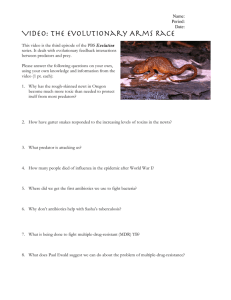
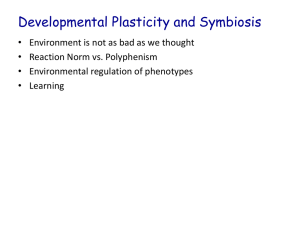
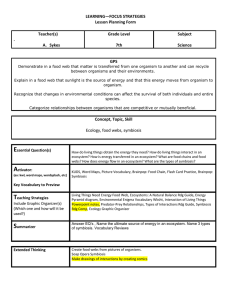
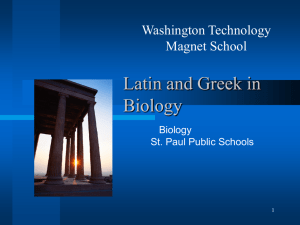

![Symbiosis[1]](http://s2.studylib.net/store/data/005449742_1-2c9de7b7b178f521480e9109673f342e-300x300.png)